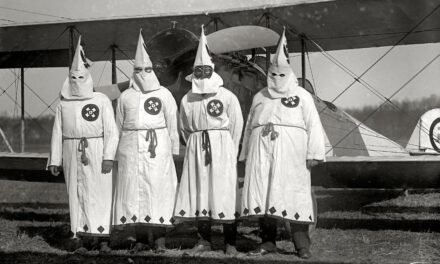
The Edward X. Delaney Series: 5 Great Crime Novels by Lawrence Sanders
Lawrence Sanders, The Anderson Tapes, The First Deadly Sin, The Second Deadly Sin, The Third Deadly Sin, and The Fourth Deadly Sin. First published by G. P. Putnam’s Sons, New York, 1970, 1973, 1977, 1981, and 1985, respectively.
Lawrence Sanders’s Edward X. Delaney series comprises five detective thrillers set in and around New York City from the late 1960s to the mid-1980s. The series takes its name from Detective Edward X. Delaney of the New York Police Department. Delaney does not make his first appearance until 80 percent of the way through The Anderson Tapes, but he then takes over as the principal protagonist of the following four books.

Lawrence Sanders. (Community Foundation of Broward)
Sanders published The Anderson Tapes in 1970 and then added new books to the series at three or four-year intervals. Books two through five are also known as the “Deadly Sins” series, beginning with The First Deadly Sin, published in 1973, and culminating in 1985’s The Fourth Deadly Sin. In each book, Delaney faces off against a brutal killer who represents one of the classic deadly sins.
Sanders was born in Brooklyn in 1920 and earned a bachelor’s degree from Wabash College in Indiana. Before he turned to writing fiction, he served in the United States Marine Corps and worked for magazines.
He was 50 years old when he published The Anderson Tapes, his first novel. The novel won the 1971 Edgar Allan Poe Award for Best First Novel from the Mystery Writers of America.
In addition to the Edward X. Delaney/Deadly Sins series, Sanders published two other multi-book series. The four books in his Commandment Series were published from 1978 to 1991. He then published seven books in his Archy McNally series, set in Palm Beach, Florida, between 1991 and 1998. After Sanders passed away in 1998, Vincent Lardo continued the McNally series.
Sanders also published some 20 other books in various genres, including adventure stories and even erotic dramas. His work was—and remains—very popular. At the time of his death, more than 58 million copies of his books were in print in the United States alone, with millions more in other countries around the world.
Book 1: 'The Anderson Tapes' (1970)
The first book in the Edward X. Delaney series can be characterized as a prequel to the subsequent four Deadly Sins books. Sanders introduces Delaney late in the book, before making him the protagonist of the rest of the series.
The Anderson Tapes chronicles the planning and commission of an apartment building robbery on New York City’s Upper East Side on Labor Day weekend in 1968. Sanders employs the unique technique of telling the story through a series of wiretap transcripts, police reports, witness interviews, letters, and other documents.
The book begins with an Author’s Note, which purports to be from Sanders but is part of the fiction. In the Note, the author says he is a crime reporter for a Newark, New Jersey, newspaper, who is working on “a continuing investigation into the uses and abuses of electronic surveillance equipment by public and private agencies.” He says law enforcement agencies are cooperating with this investigation and have granted him access to their official records.

Buy ‘The Anderson Tapes’ on Amazon
As an Amazon Associate, I earn a commission from qualifying purchases
The first 60 percent of the book describes the planning of the crime. The mastermind of the plan is John “Duke” Anderson, an ex-con from Kentucky who is looking for a big score. Through transcripts and other documents, we see how he recruits his team, arranges for mob financing for his expenses, and cases the building.
None of the criminals are particularly likable characters, but I came to realize that they each have their own peculiarities, foibles, and vulnerabilities. I didn’t find myself rooting for them, exactly, but I did find that I had some empathy for some of them. Not quite to the level of buying into a statement inscribed in one character’s diary—“Crime is the truth. Law is the hypocrisy.”—but I could see where that was coming from.
The crime gets underway at the book’s 60 percent mark. The robbery of the building—two offices and eight residential apartments—is quite ambitious and daring. The plan is almost perfect, with every detail worked out in advance. But as mastermind Anderson tells his crew, there’s always the chance of something unexpected coming along to make things go wrong.
Given the abundant surveillance to which the criminal plotters are subjected, it’s a wonder that law enforcement isn’t really on top of things. The crime is well underway before the police become aware of it—through a very clever plot device.
A big part of the problem is that the left hand doesn’t know what the right hand is doing. Afterward, Sanders has NYPD Captain Edward X. Delaney suggest that more cooperation among law enforcement agencies could help prevent crime.
Unfortunately, however, law enforcement “turf wars” seem to have persisted in the real world for decades, with tragic consequences on a far grander scale. Many critics questioned, for example, whether more inter-agency cooperation might have prevented the September 11 tragedy in 2001.
I wasn’t sure I would enjoy a book structured like this one, where the story is told through independent building blocks rather than a straightforward narrative. But in fact, I found it to be very compelling. Sanders gives readers a “you are there” sense of the criminals and a detailed look at the events—first, how the robbery plan develops, then, how it is carried out, and finally, how the police respond. Sanders drew me in and kept me hooked throughout the book.
Book 2: 'The First Deadly Sin' (1973)
The second book in the Edward X. Delaney series, The First Deadly Sin, is a great character study of two men who share the trait of pride. Captain Edward X. Delaney is justly proud of his long career in the New York Police Department and his long marriage to his wife, Barbara. Daniel Blank, meanwhile, is a wealthy young executive who lives in Delaney’s precinct on the Upper East Side and is proud of his achievements as a mountain climber.
No sin there by either man. But Blank’s pride is unhealthy. It manifests itself as a “deadly sin” and ultimately leads him to violence.
Sanders first introduces us to Blank. We learn that his fast-track business career was built in part on deceit and manipulation of others. He takes a lot of pleasure in looking at himself in the mirror (or more accurately, dozens of mirrors arrayed around his apartment) and has some predilections that might be described as “kinky.” Then he meets the mysterious Celia Montfort, who opens up a new world for him.

Buy ‘The First Deadly Sin’ on Amazon
As an Amazon Associate, I earn a commission from qualifying purchases
At a dinner party, Celia suggests that “‘true evil has a kind of nobility … I’m not talking about evil for the sake of ambition. I’m talking about evil for the sake of evil. Not Hitler—no. I mean saints of evil—men and women who see a vision and follow it. Just as Christian saints perceived a vision of good and followed that.’”
Celia awakens in Blank “a fire in the veins, a heightened awareness, a need compounded of wild hope and fearful dread.” With Celia’s encouragement, he commits a murder, and then several more. Not for any reason other than to do it and get away with it. After he kills his first victim, he feels “first of all an enormous sense of pride. That was basic. It was, after all, an extremely difficult and dangerous job of work, and he had brought it off.” Now when he looks in his mirrors, whom does he see? Maybe a “saint of evil.”
Meanwhile, Captain Delaney is a dedicated cop with a tough reputation that has earned him the nickname “Iron Balls.” He thinks he became a cop because “there is, or should be a logic to life … that is both orderly and beautiful … [but] crime, all crime, is irrational. It is opposed to the logic of life, and so it is evil.”
He is honest with himself, though. “It was perhaps due to his Catholic nurture that he sought to set the world aright. He wanted to be God’s surrogate on earth. It was, he knew, a shameful want. He recognized the sin. It was pride.” So, like Daniel Blank, Delaney also wants to be a saint, but unlike Blank, a saint for good—God’s surrogate. The question is, how far can and will Delaney go to set the world aright? Will his pride make him go too far?
The book is structured with sections alternating between Blank’s point of view and Delaney’s point of view. Readers know that Blank is the murderer before Delaney does, but this doesn’t diminish the suspense. The question for readers shifts from whether Delaney will identify the murderer to if, when, and how he will bring him to justice.
My feelings about The First Deadly Sin are mixed. It is very detailed and very long. In my opinion, the detail is a strength with respect to getting to know Captain Delaney and watching his investigative techniques. (Given that the book was published in 1973, some of those techniques are dated, of course.) I don’t know that it was as necessary, though, to spend so much time with the very unlikable Daniel Blank, especially so much time at the beginning of the book. I think some of the Blank sections could have been shortened without damage to the overall story.
But aside from that criticism, I think the book is quite good. If you’re willing to spend some time with it, and as long as you can overlook some outmoded attitudes that reflect the times, it’s well worth reading.
Book 3: 'The Second Deadly Sin' (1973)
In the third book of Sanders’s series, Edward X. Delaney is retired from his job as Chief of Detectives with the NYPD. He is adjusting successfully to life with his second wife, Monica (whom he had met in connection with his investigation in the previous book and married after the death of his first wife, Barbara), and his two young stepdaughters. He is also trying to adjust, less successfully, to retirement.
So when his former mentor asks him to investigate a difficult cold case involving the murder of a famous artist, Victor Maitland, he is receptive. The assignment comes with a catch, though: Delaney has to supervise a young detective, Abner Boone, who has gotten into trouble because of a drinking problem.

Buy ‘The Second Deadly Sin’ on Amazon
As an Amazon Associate, I earn a commission from qualifying purchases
When Delaney and Boone investigate the artist’s murder, they discover that although everyone in Maitland’s orbit recognized his talent, few seemed to like him.
None of [them] seemed particularly distressed by the sudden blanking of Victor Maitland, and made little effort to hide their indifference. Depending on the education and/or social status of the acquaintance questioned, the dead man was described as everything from ‘an offensive and disagreeable individual’ to ‘a piece of shit.’
But that doesn’t deter Delaney from going all out to find Maitland’s killer. “‘Jesus,’ Delaney said in a low voice. ‘I don’t care what the guy was, he shouldn’t be dead.’”
But Delaney’s trouble is that he also begins to like and feel sympathy for all the people in Maitland’s life, even though he is convinced that one of them is the killer. They all seem to have pretty good alibis, but each one also had a possible motive. Delaney reflects:
Cui bono? The first question of any homicide dick: Who benefits? He had a disturbed son envious of his father’s talent. A sexless wife furious at her husband’s cheating. An art dealer scorned and humiliated in public. An artist friend jealous of the victim’s integrity. A quondam mistress hating his contempt. A mother and sister deserted and left to flounder. Some very highfalutin motives for murder—but cui bono?
The evidence in the case is slim. So, as Delaney tells Monica, if there’s not enough physical evidence to break a case, you look at the people and try to determine why they do what they do. “‘You try to put yourself in their place. What drives them? What do they want? Everyone wants. But some people can’t control it. Then want becomes need. And need—I mean a real greedy need—the kind that haunts you night and day—that’s motive enough for any crime.’” Greed: the second deadly sin.
One of Delaney’s great strengths as a detective is his ability to observe and “read” people and situations. And one of Lawrence Sanders’s great strengths as a writer is his ability to describe what Delaney observes and does in meticulous detail without being tedious. His characters all feel very alive. As a reader, I liked and/or felt sympathy for them all, just as Delaney does. I knew one would be guilty, but I didn’t know which one until Delaney did.
Published in 1977, The Second Deadly Sin is, unsurprisingly, somewhat dated in terms of its descriptions of New York City and police procedures, as well as the characters’ attitudes about women and certain minorities (although it is quite sensitive with respect to Boone’s alcoholism). Nonetheless, it’s an engrossing story and a great read for crime fiction fans.
Book 4: 'The Third Deadly Sin' (1981)
In the first chapter of The Third Deadly Sin, Lawrence Sanders introduces us to Zoe Kohler, a divorced woman in her 30s who works as a secretary in the security office of a Manhattan hotel. Zoe is ordinary in appearance. She often feels invisible, adrift, and sometimes wonders if she exists. She is “disgusted” by the world, and more specifically, by men. Zoe has recently embarked on a series of “adventures” to make her mark. By the end of the chapter, Sanders has made it clear what those adventures are.
In chapter 2, we meet series protagonist Edward X. Delaney, retired Chief of Detectives of the New York Police Department. Delaney really misses being a cop, so he is thrilled when he is asked to help investigate a series of killings in midtown Manhattan hotels.

Buy ‘The Third Deadly Sin’ on Amazon
As an Amazon Associate, I earn a commission from qualifying purchases
The brutal killings are nearly identical: the victims have had their throats cut and their genitals mutilated with multiple stab wounds. But there is no apparent link between the victims, and there are few clues. The murders appear to be random—similar to the “Son of Sam” killings that terrorized New York City in 1976 and 1977, a few years before the time in which this book is set.
The reader knows what Delaney and his team do not: that Zoe Kohler is the killer, dubbed the “Hotel Ripper” by the press. But the police and the press assume that the killer is male. Serial murderers have rarely been female. When women do kill, they are usually motivated by passion or greed. Those motives don’t fit random “repeater” murders.
But as Delaney analyzes the killings, he begins to suspect that the perpetrator is in fact a woman. He questions why a woman couldn’t be as capable of murder as a man. A woman, just like a man, could feel “hatred of a type of individual or a class of individuals who, in the killer’s sick mind, are deserving of death,” or could feel “rejection not by individual or class but by society, the world, life itself.” Such feelings could lead either a man or a woman to commit murder.
This motive for murder would fit the classic definition of wrath, the third deadly sin. In some lists of the deadly sins, the third deadly sin is lust, and lust is in play here too. But the deadly sins in the books’ titles refer to the sins of the killers, and here it’s the victims who have been motivated by lust. Zoe herself is disgusted by lust. So even though Sanders isn’t explicit about it, I’ll go with wrath as the third deadly sin.
As always, Delaney shares his theories with his wife Monica. But Monica, who has immersed herself in the women’s movement, pushes back against the notion that women can be capable of such horrific acts. This dynamic between Delaney and Monica gives Sanders the opportunity to explore the question of gender at this relatively early point in the women’s movement (the book was published in 1981). Although some of the discussion seems dated, it still provides an interesting sociological context for the story.
The chapters alternate between Zoe’s perspective and Delaney’s. It’s an effective technique for ratcheting up the suspense, as the reader knows what Zoe has done before the police do. Sanders is meticulous in describing both Zoe’s thoughts and actions and the progress of the police investigation. The book is not a quick read, but Sanders rewards the patient reader with a wealth of detail about the mind of a killer, on the one hand, and the painstaking work involved in a police investigation, on the other hand.
A word of warning: some of the descriptions of the brutal murders (and one rape) are quite vivid. So if you’re squeamish, this book may not be for you.
Book 5: 'The Fourth Deadly Sin' (1985)
The Fourth Deadly Sin opens with the brutal murder of a prominent psychiatrist, Dr. Simon Ellerbee, in his Upper East Side office on a rainy mid-November Friday night. Three days later, First Deputy Commissioner Ivar Thorsen of the NYPD asks former Chief of Detectives Edward X. Delaney to assist the Department with the investigation of the murder.
Thorsen tells Delaney that he is under enormous pressure to get the case solved. Dr. Ellerbee was a wealthy, civic-minded man with friends in high places. His wife, Dr. Diane Ellerbee, a prominent psychologist (as well as a woman of exceptional beauty), and his father, a major Manhattan real estate magnate, are demanding answers.
Thorsen is also facing pressure within the NYPD. He recently persuaded the Commissioner to appoint the first Hispanic Acting Chief of Detectives, Michael Ramon Suarez. The Commissioner will name a permanent chief in late December. Thorsen wants Suarez to get the job, but it’s unlikely that he will if the Ellerbee murder hasn’t been solved by then. Suarez knows that he is out of his depth on the case, but Thorsen thinks that Delaney’s skills and experience could prove invaluable.

Buy ‘The Fourth Deadly Sin’ on Amazon
As an Amazon Associate, I earn a commission from qualifying purchases
After talking with Suarez, Delaney agrees to come on board as an unpaid consultant. After reviewing the case files with his team, he realizes that the investigation to that point has been far from thorough. There are numerous potential suspects and few clues.
“He had a disturbing hunch that this was going to be what he called a ‘loose-ends case.’ That’s what he called investigations in which nothing was certain, nothing could be pinned down. A hundred suspects, a hundred alibis, and no one could say yes or no.
“You had to live with that confusion and, if you were lucky, discard the meaningless and zero in on the significant. But how to tell one from the other? False trails and time wasted chasing leads that dribbled away.”
In an attempt to focus the investigation, Delaney asks Diane Ellerbee to identify a half dozen of her husband’s patients who may have a propensity for violence. Delaney then has his team conduct in-depth investigations of each of the six.
The story is very suspenseful. As in the previous books in the series, the descriptions of the police investigation are detailed and meticulous. The reader learns a lot about the six prime suspects, who all are fascinating characters and very different from one another. Sanders kept me guessing about the identity of the murderer until close to the end. Even though I know that the fourth deadly sin is envy, various suspects could have had that motive.
The story is very suspenseful. As in the previous books in the series, the descriptions of the police investigation are detailed and meticulous. The reader learns a lot about the six prime suspects, who all are fascinating characters and very different from one another. Sanders kept me guessing about the identity of the murderer until close to the end, when a stray remark leads Delaney to the answer.
Even though I know that envy is generally considered to be the fourth deadly sin, I couldn’t quite figure out which suspect would have had that motive. It makes sense in the end, but one of the compelling aspects of The Fourth Deadly Sin is that the motive is a large part of the mystery.
The Bottom Line: Should You Read the Edward X. Delaney Series?
With some qualifications, I highly recommend the Edward X. Delaney series, especially the Deadly Sins books. I would have liked to read an Edward X. Delaney book focusing on each of the seven deadly sins, but unfortunately, Sanders chose to cover only four of them.
On the negative side of the ledger, the books are dated in a couple of respects. Sanders is meticulous and detailed in describing police procedure. But I often found myself thinking that some current technology, like cell phones and traffic cameras, would have been immensely helpful to the police. Of course, that is common with an older book, and I doubt it would detract from the story for most readers.
More problematic are some politically incorrect attitudes and language referring to women, gays, minorities, and people with mental disabilities. I do think that, unfortunately, such attitudes and language are accurate reflections of the time in which the books are set. I’ve usually found that I’m able to shake my head and move on, but other readers may have different reactions.
These negatives are far outweighed by the positives. First, the books are very suspenseful. Whether the story involves a serial killer whom the police are trying to catch (The First Deadly Sin and The Third Deadly Sin) or a single murder with multiple plausible suspects (The Second Deadly Sin and The Fourth Deadly Sin), Sanders keeps the reader engaged in the contest between detective and killer from beginning to end.
Second, Sanders is a master of the well-drawn character. The reader gets to know the detectives working on the case as well as the murderers and the other suspects. But most of all, we spend a considerable amount of time with Delaney, both on the job and off, when he is with Monica. Delaney can be self-righteous and rigid—his NYPD nickname “Iron Balls” is on the mark—but he is also dedicated and tenacious. And he is surprisingly tender with Monica.
Delaney’s love for sandwiches provides a touch of humor throughout the series. Delaney describes himself as a “sandwich freak” and believes that “the Earl of Sandwich had been one of civilization’s great benefactors.” His sandwiches can be elaborate. One of his favorites in The Fourth Deadly Sin is his “U.N. Special: Norwegian brisling sardines in Italian olive oil heaped on German schwarzbrot, with a layer of thinly sliced Spanish onion and a dollop of French dressing.” Monica says he’s suffering from “sandwich senility.”
Third, Sanders writes very well, and he’s a pleasure to read for that reason alone. He can turn a phrase, whether he’s writing about a case, a person, a place, or an idea. His fond descriptions of Manhattan will be especially enjoyable to any New Yorker.
And fourth, there is truth in Sanders’s stories. He understands life. Near the end of the last book, Delaney muses about justice—and life:
“We all settle, don’t we? One way or another. Who gets what they dream? We all go stumbling along, hoping for the best but knowing we’re going to have to live with confusion, sometimes winning, sometimes cutting a deal, occasionally just being defeated. It’s a mess, no doubt about it, but it’s the price we pay for being alive. I like to think the pluses outnumber the minuses.”
Copyright © Brian Lokker 2021–2024. Reviews of the individual books were first published on Goodreads.







